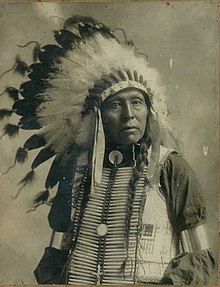Flying Hawk
| Flying Hawk | |
|---|---|
| Cetan Kiŋyáŋ | |

Chief Flying Hawk, Čhetáŋ Kiŋyáŋ.
|
|
| Oglala Lakota leader | |
| Personal details | |
| Born | March 1854 |
| Died | December 24, 1931 (aged 77) Pine Ridge, South Dakota |
| Spouse(s) | White Day Goes Out Looking |
| Relations |
Kicking Bear (brother) Black Fox II (half brother) Crazy Horse (first cousin) Sitting Bull (uncle) |
| Children | Felix Flying Hawk (son) |
| Parents | Black Fox (father) Iron Cedar Woman (mother) |
| Religion | Lakota |
Flying Hawk (Oglala Lakota: Čhetáŋ Kiŋyáŋ in Standard Lakota Orthography; a/k/a Moses Flying Hawk; March 1854 – December 24, 1931) was an Oglala Lakota warrior, historian, educator and philosopher. Flying Hawk's life chronicles the history of the Oglala Lakota people through the 19th and early 20th centuries, as he fought to deflect the worst effects of white rule; educate his people and preserve sacred Oglala Lakota land and heritage. Chief Flying Hawk was a combatant in Red Cloud's War and in nearly all of the fights with the U.S. Army during the Great Sioux War of 1876. He fought alongside his first cousin Crazy Horse and his brothers Kicking Bear and Black Fox II in the Battle of the Little Big Horn in 1876, and was present at the death of Crazy Horse in 1877 and the Wounded Knee Massacre of 1890. Chief Flying Hawk was one of the five warrior cousins who sacrificed blood and flesh for Crazy Horse at the Last Sun Dance of 1877. Chief Flying Hawk is notable in American history for his commentaries and classic accounts of the Battle of the Little Big Horn, Crazy Horse and the Wounded Knee Massacre, and of Native American warriors and statesmen from who fought to protect their families, defend the invasion of their lands and preserve their culture. Chief Flying Hawk was probably the longest standing Wild Wester, traveling for over 30 years throughout the United States and Europe from about 1898 to about 1930. Chief Flying Hawk was an educator and believed public education was essential to preserve Lakota culture. He frequently visited public schools for presentations. Chief Flying Hawk leaves a legacy of Native American philosophy and his winter count covers nearly 150 years of Lakota history.
Flying Hawk was born about full moon of March 1854, a few miles south of Rapid Creek, Lakota Territory. His father was Oglala Lakota Chief Black Fox, also known as Chief Black Fox I, Cut Forehead and Great Kicking Bear. Chief Black Fox (c.1800-c.1880) had two wives who were sisters who bore him thirteen children. Iron Cedar Woman, the youngest sister, was Flying Hawk's mother and had five children. The other wife had eight children. "In a fight with the Crows, Chief Black Fox was shot below the right eye with an arrow. It was so deep that it could not be pulled out, but had to be pushed through the ear." Chief Black Fox died when he was eighty years old. "When my father was dead a long time we went to see how he was on the scaffold where we put him. His bones were all that was left. The arrow-point was sticking in the back of his skull. It was rusted. We took it home with us."Kicking Bear (c.1846-c.1880) was Flying Hawk's full and older brother. Kicking Bear was a noted warrior and leader of the Ghost Dance. Black Fox II ("Young Black Fox") was Flying Hawk's half-brother and named for his father.Crazy Horse was the first cousin of Flying Hawk. "Though nine years the senior of Flying Hawk, Crazy Horse and Flying Hawk were constant close friends and associates, and they were cousins." Rattling Blanket Woman, the mother of Crazy Horse, was the sister of Iron Cedar Woman, the mother of Flying Hawk and Kicking Bear. They would have addressed Crazy Horse as ciye, or 'elder brother'.Sitting Bull was Flying Hawk's uncle, Chief Flying Hawk’s mother Iron Cedar Woman and Sitting Bull’s wife being sisters. At the age of 26, Flying Hawk married two sisters, Goes Out Looking and White Day. Goes Out Looking bore him one son, Felix Flying Hawk. White Day had no child.
...
Wikipedia
